Tiger Swallowtail
Papilio glaucus
The tiger swallowtail butterfly can fly up to 30 miles per hour.
Advertisement
Tiger Swallowtail Scientific Classification
- Kingdom
- Animalia
- Phylum
- Arthropoda
- Class
- Insecta
- Order
- Lepidoptera
- Family
- Papilionidae
- Genus
- Papilio
- Scientific Name
- Papilio glaucus
Read our Complete Guide to Classification of Animals.
Tiger Swallowtail Conservation Status

Tiger Swallowtail Facts
- Prey
- Plant nectar
- Main Prey
- Joe Pye weed nectar
- Name Of Young
- N/A
- Group Behavior
- Solitary
- Solitary except during mating season
- Fun Fact
- The tiger swallowtail butterfly can fly up to 30 miles per hour.
- Estimated Population Size
- undetermined
- Biggest Threat
- habitat loss and herbicides
- Most Distinctive Feature
- Scent glands, osmeteria, that look like orange horns.
- Distinctive Feature
- The Tiger Swallowtail has a wingspan of 3-6 inches, making it one of the largest butterflies in North America.
- Other Name(s)
- Eastern tiger swallowtail
- Gestation Period
- N/A
- Temperament
- docile
- Wingspan
- 3-6 inches
- Training
- N/A
- Optimum pH Level
- N/A
- Incubation Period
- N/A
- Age Of Independence
- birth
- Age Of Fledgling
- N/A
- Average Spawn Size
- undetermined
- Litter Size
- N/A
- Habitat
- Eastern tiger swallowtail butterflies are found in a range of wooded and forested areas, gardens and parks, and wetlands.
- Predators
- birds, lizards, wasps, and hornets
- Diet
- Herbivore
- Lifestyle
- Diurnal
- Favorite Food
- Joe Pye weed
- Type
- Papilio glaucus
- Common Name
- tiger swallowtail
- Special Features
- scent glands, mimicry
- Origin
- Eastern North America
- Number Of Species
- 4
- Location
- North America
- Average Clutch Size
- -23
- Slogan
- N/A
- Group
- insect
- Nesting Location
- N/A
- Age of Molting
- Tiger swallowtail larvae molt many times.
- Migratory
- 1
Tiger Swallowtail Physical Characteristics
- Color
- Brown
- Yellow
- Blue
- Black
- White
- Skin Type
- Exoskeleton
- Lifespan
- 1-7 weeks
- Weight
- less than 1 ounce
- Height
- 0.25 - 1 inch
- Length
- 1-3 inches
- Age of Sexual Maturity
- 1 week
- Age of Weaning
- N/A
- Venomous
- No
- Aggression
- Low
View all of the Tiger Swallowtail images!
The Tiger Swallowtail butterfly (Papilio glaucus), is a species of butterfly found primarily in North America. It is known for its large size, bold black and yellow striped pattern, and distinctive tails on the hind wings. They are among the largest butterflies in North America, with wingspans of up to 6 inches. Keep reading to learn more about these behemoths of the butterfly world
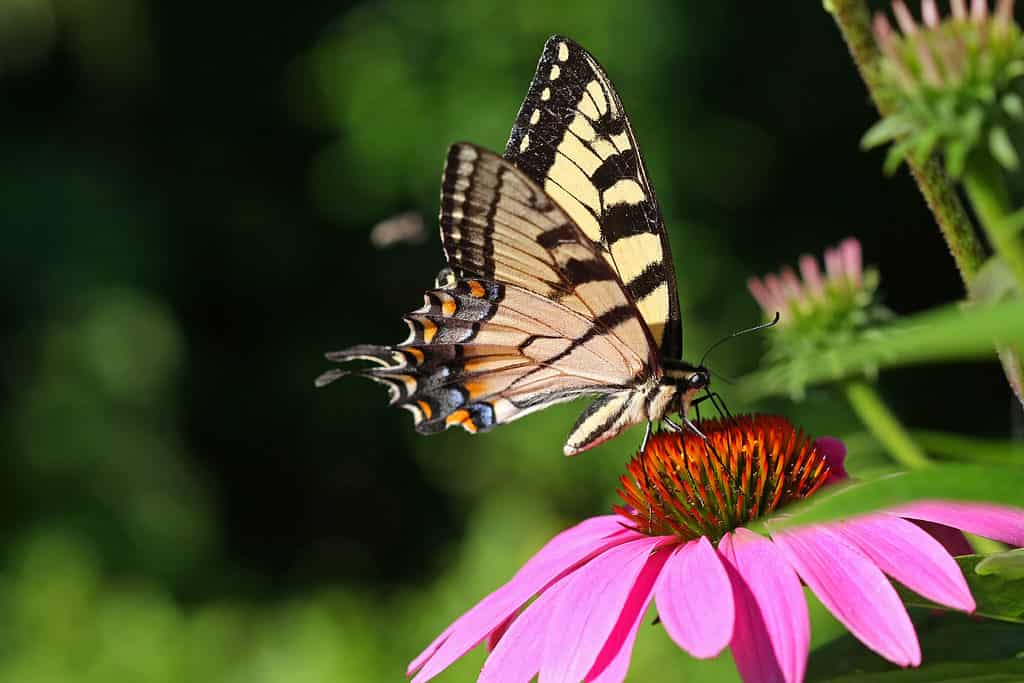
Tiger swallowtails are among the largest butterflies in North America, with wingspans of up to 6 inches.
©Ron Rowan Photography/Shutterstock.com
Five Fancy Facts about Tiger Swallowtail Butterflies
- They has two distinct color morphs, yellow and black, that are determined by the temperature during the pupal stage. The yellow morph is more common in the Northern part of their range, while the black morph is more common in the Southern part.
- They has a wingspan of 3-6 inches, making it one of the largest butterflies in North America.
- Adults are strong fliers and can fly up to 30 miles per hour.
- They are mimics. Females mimic the color and patterns of the poisonous pipevine swallowtail (Battus philenor) to deter predators.
- The first known drawing of an American butterfly featured a tiger swallowtail. It was a drawing by John White, circa 1587.
Scientific Name
The scientific name for the tiger swallowtail butterfly is Papilio glaucus. The translation of the scientific name Papilio glaucus is gray butterfly. Not the most exciting name, though tiger swallowtail is certainly more fitting. The origin of the name dates from 1889. The name first appeared in the book Butterflies of the Eastern United States and Canada by Samuel Hubbard Scudder, an entomologist and paleontologist. The book represents 30 years of work on the physiology, life history, distribution, and classification of butterflies; truly a labor of love.
Tiger Swallowtail Butterfly: Appearance and Behavior
Appearance
Tiger Swallowtail butterflies are large, striking butterflies with a wingspan that can range from 3.5-6 inches. They have a bold yellow and black striped pattern on their wings, with a distinctive tail on the hind wings. The male has a yellow-green color on its upper wing surface, and females can have either yellow or black on the upper wing surface. The females also have a blue or blue-green color on the hind wing, which is not present in males. The underside of their wings is mostly pale with a few markings.
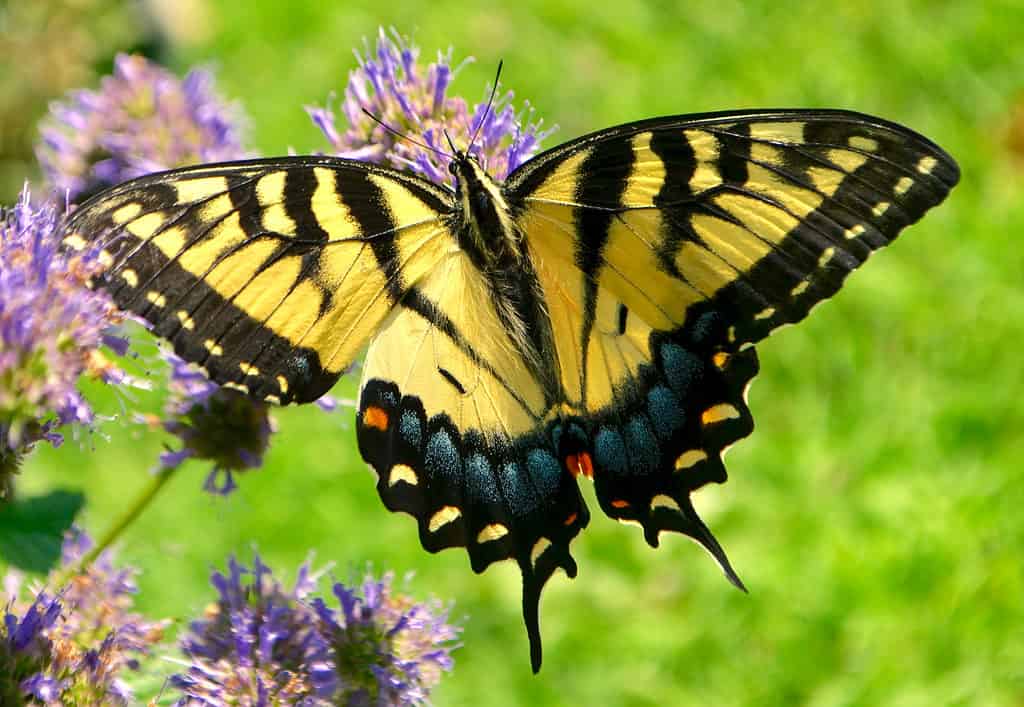
Tiger swallowtail butterflies have a bold yellow and black striped pattern on their wings, with a distinctive “tail” on the hind wings.
©Maria T Hoffman/Shutterstock.com
Behavior
Tiger Swallowtail butterflies are active during the day and are typically seen flying in gardens, fields, and along roadsides during the summer months. These lovely insects are strong and agile fliers and are known for their distinctive “fluttering” flight pattern. They are also known to fly high in the sky, making them hard to spot at times. These butterflies feed on nectar feeders and can be found visiting a variety of flowers, including milkweed, thistles, and clovers. They also feed on tree sap, rotting fruit, and occasionally carrion. They are not aggressive or territorial.
Puddling behavior in males refers to the behavior where male butterflies gather at damp ground or puddles to obtain minerals and other nutrients, such as salt and amino acids, which are used to attract mates. This behavior is seen in many species of swallowtail butterflies and is thought to be an adaptation to the lack of these nutrients in their typical food source, flower nectar.
Swallowtail butterflies have a pair of scent glands, called osmeteria, located on their hindwings that produce a pheromone that is used to attract mates. The pheromone is a chemical signal that is specific to each species and helps the male butterflies locate potential mates. The osmeteria resemble a pair of orange horns. The scent glands are also used to deter predators, as the chemicals produced by the glands can be unpleasant to some animals.
Tiger Swallowtail: Evolution and History
The Tiger Swallowtail (Papilio glaucus) has undergone a process of evolution and adaptation to its environment. Some examples of adaptations that have helped them survive and thrive include:
- Camouflage: The adults have yellow and black striped wings that resemble the wings of a wasp or hornet. This helps it avoid predators that might mistake it for a stinging insect and avoid attacking it.
- Mimicry: The larvae (caterpillars) resemble bird droppings, which helps them avoid being eaten by predators.
- Poisonous food: Their larvae feed on leaves from plants in the genus Magnolia, which contain toxic chemicals that make them unpalatable to predators.
- Flight: They have large wings that allow it to fly quickly and efficiently, which helps it evade predators and find food.
These adaptations have allowed the Tiger Swallowtail to survive and thrive in a wide range of habitats, from woodlands and forests to suburban gardens and city parks. Over time, the species has evolved to better survive in different environments and changing conditions.
History
The tiger swallowtail butterfly is one of the most recognizable and widely distributed butterflies in the United States and Canada. The Tiger Swallowtail has a long history of cultural significance in North America, and it has been used in art, literature, and mythology for centuries. The species has been known to have the same habitat range for thousands of years, and it has adapted to various types of environments, from woodlands to gardens. This butterfly has the distinction of being the first American butterfly ever to be depicted by a European. John White was an explorer, cartographer, and artist who landed on Roanoke Island, Virginia in 1585. His drawing of the tiger swallowtail is thought to date from 1587.
Tiger Swallowtail: Habitat
The tiger swallowtail butterfly’s habitat varies depending on the subspecies*, of which there are four, but generally they can be found in a range of wooded and forested areas, gardens and parks, and wetlands. The Eastern tiger swallowtail (Papilio glaucus) is native to the eastern United States, while the Western tiger swallowtail (Papilio rutulus) can be found in the Western United States. They can also be found in Southern Canada and Northern Mexico
*Once considered a single butterfly with a vast range, there are actually 4 distinct species:
- Eastern tiger swallowtail (Papilio glaucus)
- Western tiger swallowtail (Papilio rutulus)
- Canadian tiger swallowtail (Papilio canadensis)
- Appalachian tiger swallowtail (Papilio appalachiensis,)
The Appalachian tiger swallowtail is actually a hybrid! It is a cross between the Eastern tiger swallowtail and the Canadian tiger swallowtail. Hybridization is a rarity in the animal world.
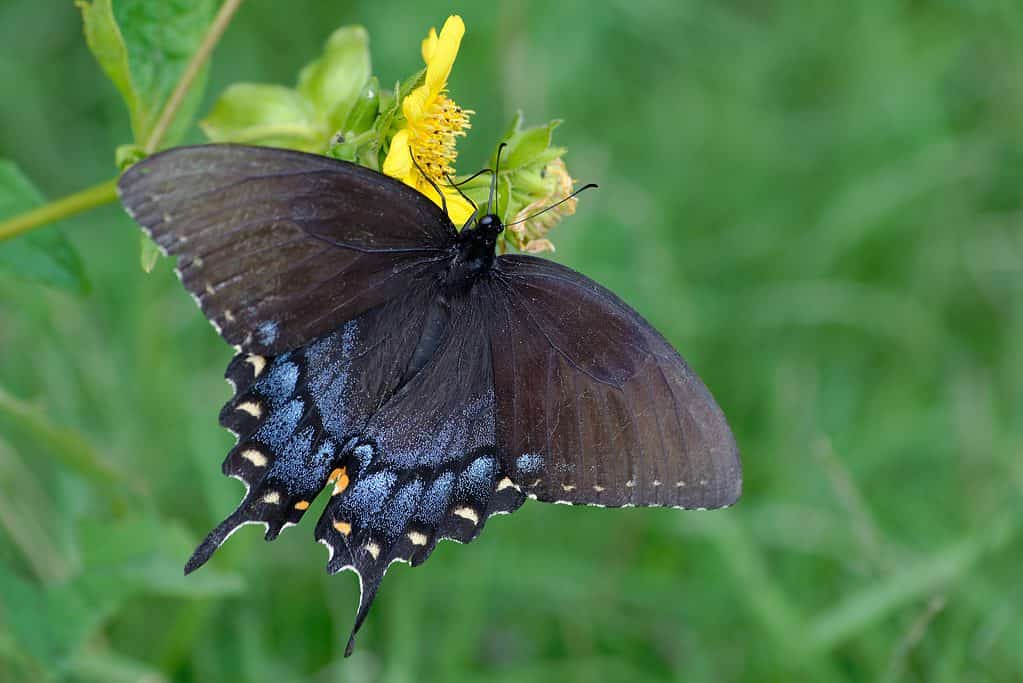
Female tiger swallowtails have a dark form.
©Thomas Woolsey/Shutterstock.com
Predators and Threats
Tiger swallowtail butterflies face several threats, including habitat loss, pesticide use, and climate change. Urbanization and agricultural development can destroy or fragment their natural habitats, reducing the availability of host plants and nectar sources. Pesticides can also harm or kill the butterflies, as well as the plants they rely on. Climate change can also affect the timing of the butterflies’ life cycle, making it difficult for them to synchronize with the availability of food sources. Additionally, the introduction of non-native species, such as the parasitoid wasp, can also have a negative impact on tiger swallowtail butterflies.
Habitat Loss
Habitat loss and fragmentation are among the most significant threats to tiger swallowtail butterflies. As urbanization and agricultural development continue to expand, natural habitats such as woodlands, wetlands, and meadows are being destroyed or fragmented, reducing the availability of host plants and nectar sources for the butterflies. This can make it difficult for them to find the resources they need to survive, and can also isolate populations, making them more vulnerable to extirpation.
Herbicides
Herbicide use is also a significant threat to tiger swallowtail butterflies. Herbicides can harm or kill the butterflies directly, as well as the plants they rely on for food and habitat. This can reduce the population of the butterflies and make it difficult for them to find the resources they need to survive. Additionally, herbicides can also have sublethal effects on the butterflies, such as reducing their ability to fly, which can make it difficult for them to find food or mates.
Climate change is also a threat to tiger swallowtail butterflies. The timing of the butterflies’ life cycle may be affected by temperatures and precipitation patterns change, making it difficult for them to synchronize with the availability of food sources. Additionally, changes in temperature and precipitation patterns can also affect the availability of host plants and nectar sources, which can further reduce the population of the butterflies.
The introduction of non-native species can also have a significant impact on tiger swallowtail butterflies.

Herbicide use is a significant threat to tiger swallowtail butterflies.
©PiggingFoto/Shutterstock.com
Predators
Tiger swallowtail butterflies are preyed upon by a wide range of animals, including birds, lizards, and other insects such as wasps and hornets. Birds such as the Eastern Phoebe, Baltimore Oriole, and American Goldfinch are known to feed on adult tiger swallowtails. Lizards, such as the six-lined racerunner, may also prey on adult butterflies.
The caterpillars of tiger swallowtails are also vulnerable to predation. Ants, wasps, and birds are known to feed on caterpillars. For example, the paper wasp is known to prey on caterpillars. Additionally, parasitic wasps and flies may also lay their eggs on tiger swallowtail caterpillars, with the resulting larvae feeding on the caterpillars.
It’s important to note that Tiger swallowtail butterflies also have some natural camouflage, the adult butterflies are often mistaken for wasps or bees, and their caterpillars are often mistaken for bird droppings, which can help them avoid predators
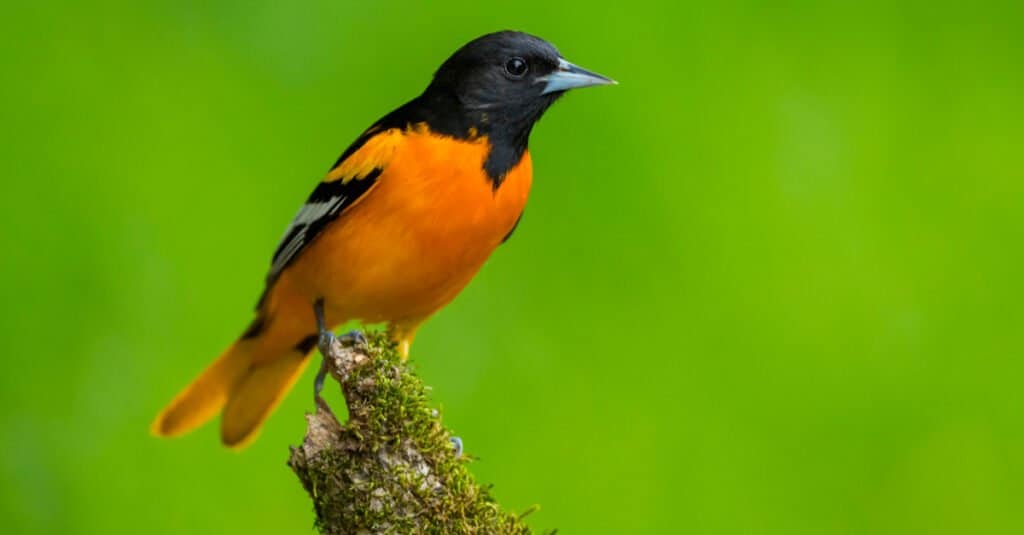
The Baltimore oriole is known to eat tiger swallowtail butterflies.
©Agami Photo Agency/Shutterstock.com
Lifecycle
The Tiger swallowtail butterfly has four stages in its life cycle: egg, larva (caterpillar), pupa (chrysalis), and adult.
1. The egg stage typically lasts for about a week. The female butterfly lays her eggs singly on the leaves of host plants, such as cherry, ash, or tulip poplar trees.
2. The larva stage, or caterpillar stage, lasts for about two to three weeks. The caterpillars are green. They eat the leaves of their host plants, typically cherry, ash, and tulip poplar.
3. The pupa stage, or chrysalis stage, lasts for about two weeks. The chrysalis is brown and has a mottled pattern.
4. The adult stage, which is the butterfly, emerges from the chrysalis and lives for about two to four weeks. The adult butterflies are large, with a wingspan of 3-4 inches, and have black, yellow, and blue markings. They feed on nectar from flowers and tree sap.
Tiger swallowtail butterflies typically have one generation per year. In some warmer regions, there may be two or more generations.
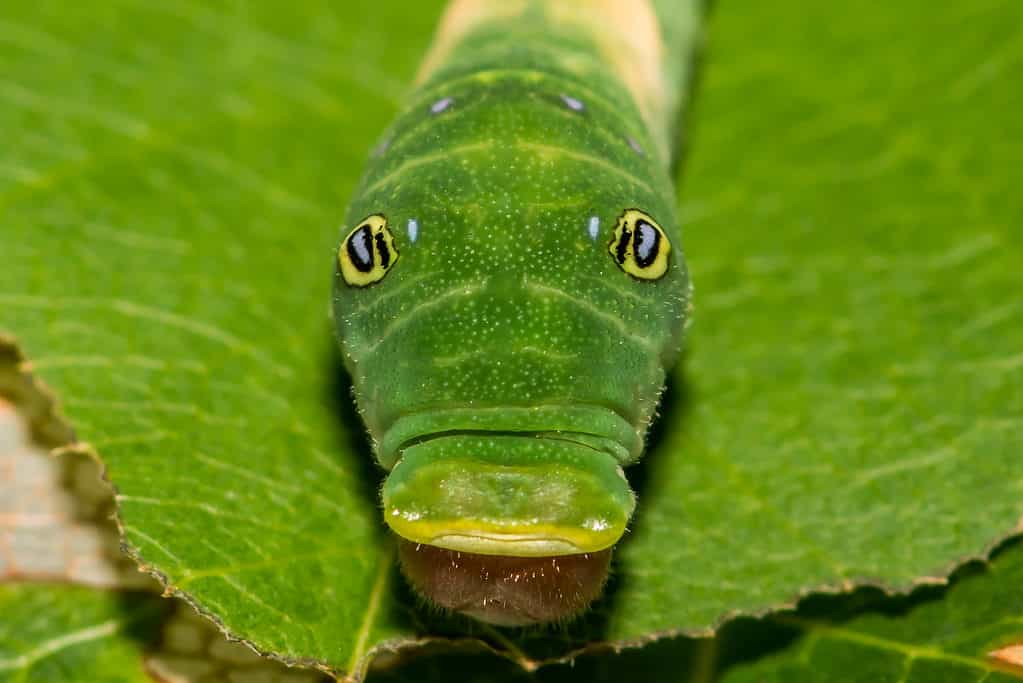
Tiger swallowtail caterpillars (larvae) are green, with eyespots.
©Jay Ondreicka/Shutterstock.com
Conservation Status
The tiger swallowtail butterfly is not considered to be a threatened or endangered species. However, as with many other butterfly species, their populations may be declining due to habitat loss and other human activities. It is important to protect and preserve their habitats in order to maintain healthy populations of tiger swallowtail butterflies.
Up Next:
View all 133 animals that start with TTiger Swallowtail FAQs (Frequently Asked Questions)
Where are Eastern tiger swallowtail butterflies found?
Eastern tiger swallowtails are native to the Eastern United States, though their habitat ranges as far as Southern Canada and Northern Mexico
What do Eastern tiger swallowtail eat?
An Eastern tiger swallowtail butterfly’s diet consists of flower nectar. They like Joe Pye weed, thistles, and milkweed.
How many distinct species of tiger swallowtail butterflies are there?
There four distinct species of tiger swallowtail butterflies:
- Eastern tiger swallowtail (Papilio glaucus)
- Western tiger swallowtail (Papilio rutulus)
- Canadian tiger swallowtail (Papilio canadensis)
- Appalachian tiger swallowtail (Papilio appalachiensis,)
The Appalachian tiger swallowtail is actually a hybrid! It is a cross between the Eastern tiger swallowtail and the Canadian tiger swallowtail. Hybridization is a rarity in the animal world.
What is puddling and why do male tiger swallowtail butterflies puddle?
Puddling behavior in tiger swallowtail butterflies refers to the behavior where male butterflies gather at damp ground or puddles to obtain minerals and other nutrients, such as salt and amino acids, which are used to attract mates. This behavior is seen in many species of swallowtail butterflies and is thought to be an adaptation to the lack of these nutrients in their typical food source, flower nectar.
Are Eastern tiger swallowtail butterflies nocturnal or diurnal?
Eastern tiger swallowtail butterflies are diurnal. They fly around during the day looking for flowers rich with nectar to dine on.
Thank you for reading! Have some feedback for us? Contact the AZ Animals editorial team.
Sources
- usda.gov, Available here: https://www.fs.usda.gov/wildflowers/pollinators/pollinator-of-the-month/TigerSwallowtail.shtml
- nhpbs.org, Available here: https://nhpbs.org/natureworks/easterntiger.htm
- wikipedia.org, Available here: https://en.wikipedia.org/wiki/Papilio_glaucus
















